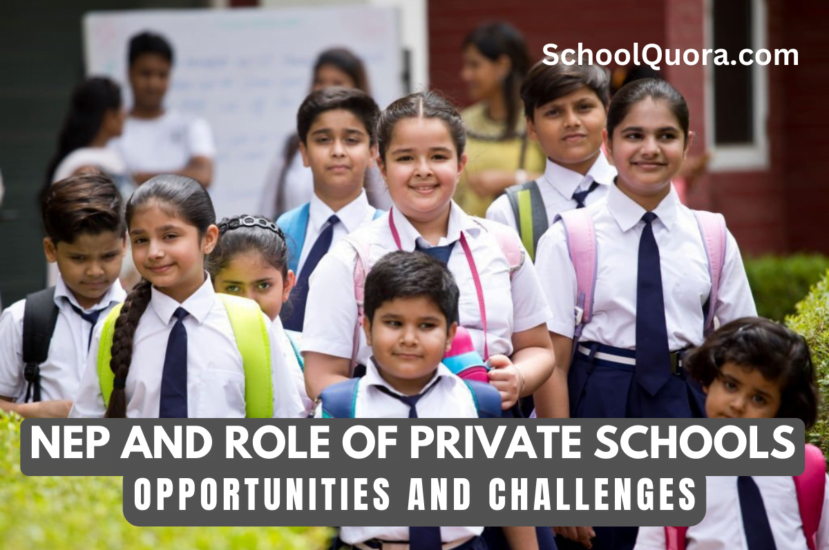The National Education Policy 2020 is a comprehensive document that explains the vision and objectives of the Indian education system, as well as the tactics and reforms necessary to accomplish those objectives. The inclusion of the private sector in education is one of the fundamental aspects of the policy, as the government strives to harness the knowledge and resources of the private sector to improve the quality and accessibility of education in the country.
The private sector can contribute to the education system in a number of ways, including:
Contributions
1. Investment in education:
The private sector can invest in education by establishing schools, colleges, and universities or by partnering with existing educational institutions to offer funds and resources. This can strengthen the infrastructure and facilities of these institutions and give students with additional educational possibilities.
Private sector investment in education can be a substantial source of revenue and resources for schools, colleges, and universities, especially in places with inadequate state funding. This investment may consist of establishing new educational institutions or forming partnerships with existing universities to supply funding and resources.
By giving funding for the construction of new buildings, the purchase of new equipment, or the refurbishment of existing facilities, an investment in education can help to improve the infrastructure and facilities of educational institutions. This can contribute to the improvement of the learning environment for students and the quality of education.
In addition to enhancing infrastructure and facilities, private sector investment in education can provide students with more educational options. For instance, private sector firms may offer financial aid or scholarships to students from poor backgrounds, or they may establish programmes to help academically struggling kids with additional support.
Private sector investment in education can be a valuable resource for improving the quality and accessibility of education, but it is essential to ensure that such investment is consistent with the goals and values of the education system and does not perpetuate inequities or disadvantage certain student groups.
2. Innovation in teaching and learning:
Innovative ways to teaching and learning, such as the use of technology, experiential learning, and project-based learning, can be introduced to the education system by groups from the private sector. This can help make education more relevant and interesting for pupils.
Private sector firms can contribute a variety of new teaching and learning strategies to the school system, thereby making education more interesting and relevant for students. Examples of these strategies include:
a. Use of technology:
Organizations in the private sector may employ technology to improve teaching and learning by, for example, providing online learning platforms or bringing virtual reality or other interactive technologies into the classroom. This can assist make education more dynamic and interesting for students, as well as facilitate their access to educational resources from anywhere.
b. Experiential learning
Organizations in the private sector may employ experiential learning techniques such as field excursions, internships, and hands-on projects to provide students with real-world experiences that aid in their comprehension and application of what they are learning. This can increase the significance and relevance of education for students.
c. Project-based learning:
Organizations in the private sector may employ project-based learning methodologies, in which students work on long-term projects that require them to apply their knowledge to real-world circumstances. This can help make education more interactive and engaging, as well as help students develop essential skills such as problem-solving and teamwork.

Overall, the employment of innovative teaching and learning strategies by private sector businesses can make education more engaging and relevant for students, as well as better prepare them for success in the workplace. It is essential, however, to ensure that these techniques are consistent with the goals and values of the education system and do not perpetuate inequalities or disadvantage certain student groups.
3. Employment opportunities for teachers:
Particularly in regions where there may be a dearth of qualified educators, the private sector might provide work opportunities for teachers. This can aid in enhancing the quality of teaching and learning in these fields.

Particularly in locations where skilled educators may be in limited supply, private sector enterprises might provide employment possibilities for teachers. This guarantees that students have access to trained and experienced educators, which can increase the quality of teaching and learning in these fields.
Organizations in the private sector may hire teachers directly or cooperate with schools or other educational institutions to contract teachers. This can provide employment chances for teachers wanting flexible or part-time employment, or those seeking experience in a variety of educational settings.
In addition to providing employment possibilities, private sector firms may also provide instructors with opportunities for professional growth and training. This can help guarantee that instructors have the necessary skills and knowledge to be effective educators, as well as improve the quality of teaching and learning throughout the school system.
In general, the private sector may play an important role in providing employment opportunities and professional development for teachers, especially in places where there may be a shortage of qualified educators. However, it is crucial to ensure that these chances are provided fairly and equally and do not perpetuate inequalities or disadvantage certain groups of teachers or pupils.
While the private sector can provide several benefits to the education system, its position in education must also take into account a number of obstacles. Several of these obstacles include:
Obstacles
1. Equity concerns:
Institutions in the private sector could not be accessible to all students, especially those from poor families. This can perpetuate inequalities in the school system and establish a two-tiered system in which only a select few kids have access to a great education.
Equity is one of the primary concerns regarding the private sector’s involvement in education. Institutions in the private sector could not be accessible to all students, especially those from poor families. This can perpetuate inequalities in the school system and establish a two-tiered system in which only a select few kids have access to a great education.
Numerous things may contribute to its inaccessibility. For instance, some students and their families may be unable to afford the tuition at private sector colleges. This can create educational barriers and restrict the chances open to specific kids.
Private sector colleges may also be located in affluent locations, making them less accessible to students from impoverished communities. This can create a situation in which kids from more fortunate backgrounds have better access to a decent education than those from poor backgrounds.
To address these issues of equality, it is essential that private institutions be available to all students, regardless of their background or income. This can be accomplished through policies such as financial aid programmes, subsidies, and scholarships that make private sector education more affordable and accessible for students from poor families. It is also crucial to ensure that private institutions are placed in regions that are accessible to all students and that there are sufficient transit choices for students from all neighbourhoods to attend.
2. Profit-driven motivations:
Concerning the private sector’s involvement in education, the issue of profit-driven motivations is a potential obstacle. Private sector organisations may be driven by profit rather than the quality of education, which may result in a focus on economically viable locations rather than those with the most need. This could result in a lack of funding in specific areas or support for specific student groups.
For instance, private sector businesses may be more motivated to invest in institutions of higher education, such as universities, because they can charge greater tuition rates and may have a larger pool of prospective students. This may lead to a lack of investment in primary and secondary education, especially in regions where the demand for higher education is low.
Additionally, private sector organisations may be more willing to invest in places that are more affluent or have a greater need for education than in areas that are more disadvantaged or have a lower demand. This could result in a lack of funding in specific areas or support for specific student groups.
In order to solve these issues, it is necessary to guarantee that private sector businesses are held accountable for the quality of education they deliver and are not motivated purely by profit. This can be accomplished by rules, accrediting requirements, and quality assurance methods, which serve to ensure that private sector institutions are held to the same standards as public institutions. In addition, it is essential to ensure that rules are in place to incentivize private sector businesses to invest in areas with the greatest needs and to provide assistance to disadvantaged students.
3. Regulation and oversight:
Concerns may exist over the regulation and control of private sector institutions, especially with regard to the quality of education they provide. This can be particularly relevant in nations where the education system is predominantly supported by the government, as there may be worries about the accountability of private sector institutions.
Another obstacle that can develop when it comes to the private sector’s involvement in education is the question of regulation and oversight. Concerns may exist over the regulation and control of private sector institutions, especially with regard to the quality of education they provide.
In nations where the government finances the majority of the education system, there may be issues over the responsibility of private sector groups. This can be particularly pertinent if private sector entities get public money or if they obtain tax cuts or other benefits. In such circumstances, it is crucial to ensure that proper policies and regulations are in place to hold private sector institutions accountable for the quality of education they provide.
There may also be worries about the level of openness and accountability of private sector entities, particularly in terms of their financial operations. This can be a problem if private sector entities are not obligated to publish their financial information or if their financial arrangements make it difficult to trace their funds.
To address these issues, it is essential that proper policies and regulations are in place to ensure that private sector institutions are accountable for the quality of education they provide and that their financial operations are transparent and accountable. This can be accomplished by policies such as requirements for financial reporting, accreditation standards, and quality assurance methods. In addition, it is essential to ensure that proper processes are in place to monitor the performance and financial health of private sector organisations and to address any discovered shortcomings.
4. Competition with public institutions:
When it comes to the private sector’s involvement in education, the problem of rivalry with public institutions can be a challenge. The presence of private sector firms in education may result in competition with state institutions, which may have financing and resource repercussions.
There may be worries over the impact of private sector institutions on public institutions in nations where the education system is predominantly sponsored by the government. For instance, there may be concerns regarding the amount of available money for public institutions if private sector organisations are also competing for funding.
Concerns may also exist around the allocation of resources, including as textbooks, technology, and other instructional materials. In circumstances where few resources are available, private sector institutions may be able to gain a bigger part of these resources, which could affect the resources available to public institutions.
In order to address these issues, it is necessary to implement rules and regulations that ensure public and private institutions compete on an equal playing field. This can be accomplished by policies such as financing formulae, resource allocation techniques, and legislation that hold private sector organisations to the same standards as public sector institutions. In addition, it is essential to ensure that proper processes are in place to monitor the performance and financial health of private sector organisations and to address any discovered shortcomings.
While the private sector can bring many benefits to the education system, it is vital to carefully assess the potential problems and implement policies and regulations to ensure that all students have access to a high-quality education.
Incorporating the private sector into education brings both opportunities and obstacles. It is crucial that the government and other stakeholders carefully weigh the possible benefits and downsides of private sector involvement and ensure that legislation and regulations are in place to ensure that all students have access to a quality education.





Leave a comment